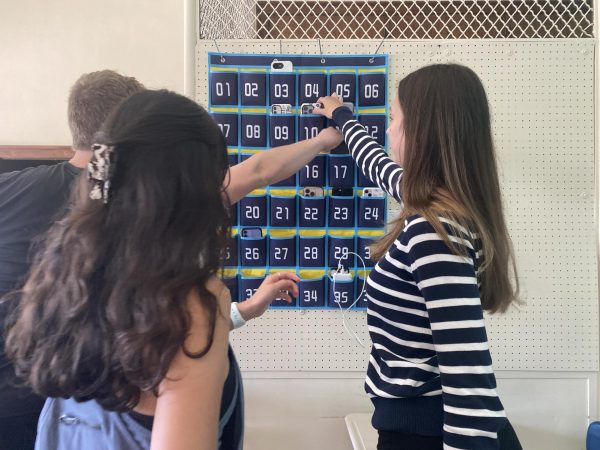Is low self-esteem the new normal?
Hours before the sun is due to come up, the girl pulls herself from slumber. She straightens her hair, plans an outfit, puts on makeup, does everything in her power to make herself feel at least somewhat beautiful. But as she arrives at school in the morning and stares at her reflection in the dirty, cracked bathroom mirror, she realizes that her efforts were in vain.
She’s still not happy with the way she looks, especially not in comparison to the hundreds of pretty teenage girls that she encounters every day. The notion that she isn’t as good as her peers is lingering in the depths of her mind, eating away at her, but she slaps a smile on her face and pretends everything is okay.
Unfortunately, this mindset is a reality for many teenage girls and boys.
Poor self-esteem is becoming increasingly common within modern day society. It is so common that it seems to have become a cultural norm, particularly in high school students. The teenagers within the walls of Lane are no exception.
Mr. Cox, Lane’s social worker, works with hundreds of Lane students every year, and said that at least 50 percent of those he works with struggle with low self-esteem.
“I think it’s more common than people like to let on,” Ms. Carqueville, a counselor, said. The causes of low self esteem are unique to each individual. However, through research and experience with hundreds of clients, Cox has determined that the root of poor self-esteem typically comes from familial issues.
“Most of us develop self esteem through relationships with family members,” Cox said. “If you have a caring parent, they’ll tell you, ‘You’re beautiful. I love you. You’re safe. You’re secure.’ If you don’t, then forget it, right? So I think it really starts with family.”
According to Cox, being a part of a community that fosters you, attending a school that cares for you, and growing up in an enriching environment are other components that influence self-esteem.
“There are a lot of factors,” Cox said, “but I think family’s the key.”
Poor self-esteem often occurs simultaneously with mental illnesses, particularly depression and anxiety.
“I think the firmer and better your self esteem, the more equipped you are to deal with mental health issues,” Cox said.
Although it is extremely common for high school students to have low self-esteem, that doesn’t mean it can’t be severe. In fact, in many cases, it can be nearly debilitating, and can sometimes be life-threatening.
Grace Winter, Div. 850, is one of the many students that has had a previous struggle with self-image, occurring in tandem with a depressive episode.
“When you’re on the edge of ending your life you’ll look for anything to help you go back to who you were,” Winter said. “Any kindness shown helps amazing amounts, but if people are continuously bringing you down it makes you bring yourself down as well, and that isn’t OK. Teenagers need just as much help as other people, and we need to realize that.”
The constant, unavoidable presence of media makes poor self-esteem overwhelmingly prevalent among Lane students.
“I think we have issues with social media,” Carqueville said. “People only like to post when something is wonderful in their life, like, ‘look at me, I’m here,’ and ‘look at me, I’m doing that.’ No one really wants to recognize or publish when things are going bad. When you go online and you’re having a tough day and you say, ‘oh, they’re doing this and I’m not doing anything,’ or ‘look at that person, they have so many friends and I’m here by myself.’ Social media plays a big role in self-esteem, and it plays a bigger role in negative self-esteem.”
Improving self-esteem in high school students is what the counseling department aimed to accomplish with the Open Lunch Group, a five-week program led by Carqueville. Students of all ages met in the CCC on Thursdays to form a safe space for discussion.
“Everyone came in a little bit scared to talk about those things, and then towards the end they all were friends, and I really loved to see that,” Carqueville said. “It made me really happy because sometimes self esteem can be boosted when you have positive support from another person.”
The theme of the discussion varied from week to week, but always tied into building self-esteem. The group’s topics included self-efficacy, assertion, and positive self-talk. Participants included students from all grade levels.
“There’s one group that I’m thinking of in particular,” Carqueville said. “There was a gentleman who was a freshman and there was a girl that was a junior, and there was a girl that was a senior and they all got along so well. It was cool because the senior was able to say ‘I understand how you feel,’ and ‘I’ve been there.’ There was a lot of support from different ages, and it was really wonderful.”
Self-image issues in teenagers and children are often minimized because of their age, and how common it is in today’s society. The group not only aims to assist Lane students who are struggling with a poor self-image, but also simultaneously dismantles the stigma that surrounds the issue.
“I have had really low self-esteem in the past. I still tend to feel bad about the way I look and the decisions I’ve made in the past, and it is really hard a lot of the time,” Winter said. “People think that teenagers are just being teenagers and complaining about little things that don’t matter, but they do.”
Your donations directly fund the Lane Tech student journalism program—covering essential costs like website hosting and technology not supported by our school or district. Your generosity empowers our student reporters to investigate, write, and publish impactful stories that matter to our school community.
This website is more than a publishing platform—it's an archive, a research tool, and a source of truth. Every dollar helps us preserve and grow this resource so future students can learn from and build on the work being done today.
Thank you for supporting the next generation of journalists at Lane Tech College Prep!

Lara Sonuga is a senior at Lane and one of the Warrior's chief editors. Writing, reading, and listening to music have been her favorite pastimes since...




